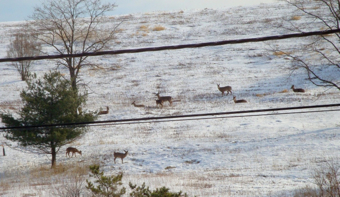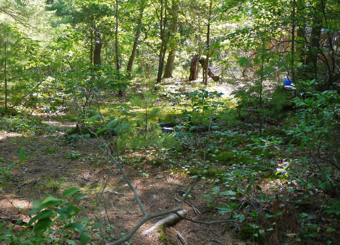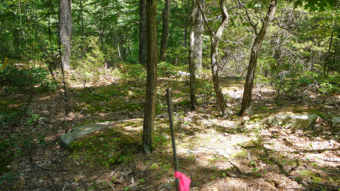 There are between 800 to 2,000 deer in Shelton, and many of them should be killed if the city wants to preserve vegetation, limit the spread of Lyme disease, and lessen the chance of motorists running into the animals on roads.
There are between 800 to 2,000 deer in Shelton, and many of them should be killed if the city wants to preserve vegetation, limit the spread of Lyme disease, and lessen the chance of motorists running into the animals on roads.
That’s the main finding of a draft report from a committee of residents who have been studying the local deer population for the past year.
Does this mean sharpshooters will be roaming the city gunning down bucks and does?
No.
The report recommends allowing recreational bowhunting on a few local city-affiliated open spaces as the best way to start culling Shelton’s deer population.
A conservation official estimated Monday that about 50 to 100 deer would be “removed” through hunting.
“Recreational hunting is a cost-effective management technique which has been used successfully by a number of municipalities in Fairfield County, with a resulting drop in deer/vehicle strikes and landscaping damage,” the report says. “Shelton should introduce a hunting program on city open space properties in an incremental fashion, starting with bowhunting on a small number of suitable properties.”
The committee will hold a meeting 7 p.m. Feb. 10 at City Hall to hear from the public about the findings, and may vote on whether to send the report to the Board of Aldermen for more action.
The Problem
Aldermen appointed the nine-member “Ad Hoc Deer Committee” in September 2013 at the request of the Conservation Commission, which sent a letter to the Aldermen in June 2013 saying that the city’s “rising deer population is degrading city-owned conservation areas.”
The committee has been holding public meetings to research the issue since.
Click here to visit a blog created by the committee detailing its work.
Shelton is something of a model community in terms of preserving open space even as more acreage is gobbled up every year by commercial and residential development.
But with development displacing more and more deer into smaller and smaller areas, the animals have feasted on the vegetation there.“The city has a lot of open space and we recognized that some of that open space was being degraded by the overgrazing of the deer population,” Thomas Harbinson, the chairman of the Conservation Commission, said Friday (Jan. 30).
The committee also found that deer gobble up more and more vegetation in residential areas, and also damage local farms’ crops to the tune of thousands of dollars a year.
Harbinson said said the deer committee’s work shed light on other issues as well.
Police Chief Joel Hurliman, for example, presented stats showing the city has an average of 49 “deer-vehicle strikes” reported per year in the city, not including collisions on Route 8. Of the 147 incidents from 2001 to 2013, officers euthanized deer in 79 cases.
And Kirby Stafford, an entomologist at the Connecticut Agricultural Experiment Station, told the committee that the deer population should be brought down to eight to 12 animals per square mile, which would limit the spread of ticks carrying Lyme disease.
The report estimates there are currently about 50 deer per square mile in the Shelton area, but emphasizes the number is an estimate.
“You realize that there’s some pretty impactful human interaction with deer that might need to be addressed beyond what we saw from a conservation perspective, the deforestation,” Harbinson said.
Solutions
The committee, after reviewing the effects of local deer overpopulation, then looked at several possible solutions.
They included targeting female does with sterilization darts at a cost of $1,000 a pop, to physically relocating deer, to luring the animals into “four-poster devices” in which insecticide could be applied to kill ticks, to fencing, and hunting.
The committee’s report concludes most of the options would be cost-prohibitive, or ineffective if not combined with hunts to reduce the current number of deer.
Example — in 2009, a deer fence was installed around Eklund Garden at 10 Oak Valley Road.

 In 2014, the city’s Conservation Agent, Teresa Gallagher, assessed identically sized plots inside and outside the fencing.
In 2014, the city’s Conservation Agent, Teresa Gallagher, assessed identically sized plots inside and outside the fencing.
“Inside the deer fence, there were 27 healthy oak saplings, along with 10 white pine,” the report says. “Outside the deer fence, there was one oak sapling and five white pine, all heavily stunted from deer browse.”
But Shelton has 2,000 acres of open space and the vast majority is obviously not fenced off. Gallagher said in an email Monday (Feb. 2) that taking inventories of those spots around town was depressing at times.
“I knew the forests were thinning and there was browse damage, but did not realize the extent of the species loss until I inventoried plots for the deer report,” she said.
The ground of a wooded open space along Long Hill Avenue was “barren” of plants. “Even off of Nells Rock, where there is still some greenery, I was not able to find maple or oak saplings. The deer eat them.”
But fencing off every parcel of open space in Shelton would be cost-prohibitive, and while it would protect vegetation, it wouldn’t help limit deer ticks or keep the animals off the roads.
“Of all options, hunting does seem to be the best or most viable option,” Harbinson said.
The report does not identify on exactly which properties the hunts should occur, but recommends the city issue special hunting permits subject to background checks, references, and interviews, with a preference given to Shelton residents.
Gallagher said that figuring out an ideal deer population is difficult, partly because estimates of how many deer there are locally vary so much.
The “browse assessments” like the one at Eklund Garden “can tell you there are too many deer, but not whether you have 20 percent too many deer, or whether it’s double or triple the number of deer the land can support,” she said.
“If the goal is to eliminate tick-borne illnesses, then we probably would indeed need to remove the majority of the deer via professional culling to get the population down to 8 – 12 deer per square mile, but the Deer Committee did not make that recommendation,” Gallagher went on.
To achieve that, she said the city would probably need to employ professional hunters.
With bowhunting on some open space, “realistically, we are probably talking about removing a maximum of 50 or 100 deer,” Gallagher said.
While that may not be a drastic reduction with a deer population of between 800 to 2,000, “it can be significant on the properties being hunted, enough to allow plants to regenerate, which is what other towns have experienced.”
Currently, hunting is prohibited on public open space in Shelton. It is allowed on private property — with the owner’s permission, of course — and on certain parts of the land the Aquarion Water Company owns in the city, if hunters get special permits from the company.
The report also recommends emulating programs in Redding and Newtown in which volunteers match hunters with private property owners.
Other recommendations include:
- Creating a “Deer Management Committee” after disbanding the ad-hoc group to work out details and logistics of implementing recommended actions;
- Collect and monitor more data on the local deer population;
- Do public outreach to involve more residents in controlling the local deer population — e.g. “discouraging deer via landscaping, fencing, deer repellents; conducting daily tick checks” and discouraging the feeding of animals.